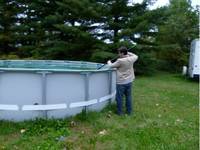Tips for winterizing your pool will make sure re-opening in the spring is trouble-free

Photo by Nicholas Paul
I am in the process of closing my above ground pool for the winter. It seems that my neighbor did it incorrectly this past spring, and when he went to reopen the pool this year, he appeared to have quite a bit of damage. What steps can you suggest to ensure that I will not have to endure the same difficulties that my neighbor experienced this past pool season ?
—Tina B., Saline
The cannon balls and Marco Polo games are soon to take a backseat until next season. But correctly winterizing your pool will ensure that you will soon hear the laughter and splashes of a trouble-free pool opening next year. This is not a difficult process, and a few relatively easy steps will allow you to savor the joys of pool ownership.
According to Scott Hoover, owner Midwest Pools Inc., who closes about 700 pools a year here in Michigan, it is always best to wait until the water temperature is approximately 65 degrees. Waiting for this decrease in water temperature will help to stop or slow down the growth of algae.
The first step is to thoroughly clean the pool. Be sure to skim, brush and vacuum the bottom and sides ensuring removal of al algae and/or bacteria growth.
Next, it is important that the water condition is at proper levels, because any current issues can multiply the time it takes to re-open the pool in the spring. Check the chlorine alkalinity, water hardness and Ph levels and adjust accordingly.
You can purchase pool winterizing kits at your local hardware stores. A helpful website is intheswim.com.
Next, add scale metal and stain control, granular chlorine, (pool shock) and algaecide as needed.
Clean and backfill the pump according to the manufacturer's instructions. Then, if possible, remove the pump and related hoses and store into a non-freezing area such as a basement or garage.
If your pump must remain outside, add pool antifreeze — not auto antifreeze, as this could cause further damage. Be sure not to wrap or cover the pump or heater, as this could encapsulate the moisture, which will cause rust unless it has a “breathable cover”.
If your pool has a heater, you must remove the winterizing plug and turn off the gas. Failure to do so could be a very expensive repair.
Lower the pool level approximately one to six inches below the skimmer level by draining it. You may have to remove any fittings to your filters and shut off any valves or insert freeze plugs.
To relieve ice pressure and possible damage to your pool, you will need to install a water pillow and string it evenly in the center of the pool.
Hoover states one of the most common repairs is needed because all of the water was not drained from the pump or heater. So be sure to follow the directions carefully and, before you know it, you’ll be enjoying underwater tea parties in the spring again.
Paul is a State of Michigan Licensed Builder. Paul serves as President and founding member of Nationally franchised HandyPro Handyman Service, servicing Washtenaw, Wayne and Oakland Counties. www.handypro.com. Listen to Paul every Saturday at 11 a.m. on “It’s Your Business, Make It Happen” WAAM Talk 1600AM. Email questions or comments to kpaul@handypro.com.


Comments
Dog Guy
Sat, Oct 1, 2011 : 1:37 p.m.
Also, it would be nice if you put an ounce of methoprene in the water over your pool's winter cover to prevent mosquitos from maturing.
Keith A. Paul
Mon, Oct 3, 2011 : 8:39 p.m.
Thanks for the tip Dog Guy.